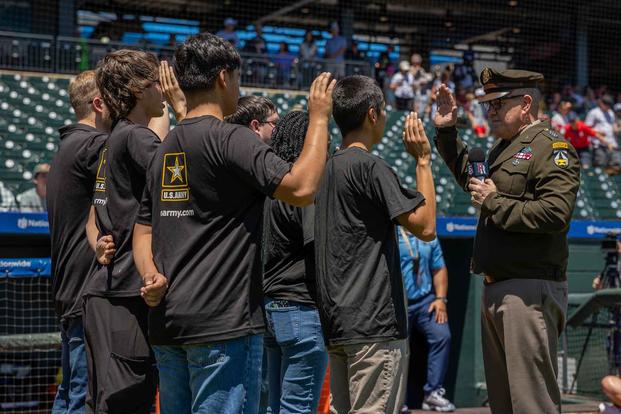
We think this is important to read how the military is analyzing and explaining its problems in recruiting, so we are posting this article originally entitled, “Army Sees Sharp Decline in White Recruits.” We continue to send veterans into classes to tell the truth about the U.S. military and what it does at home and around the world and why students should not go in the military.
By Steve Beynon
From Military.com | Original Article
The Army‘s recruiting of white soldiers has dropped significantly in the last half decade, according to internal data reviewed by Military.com, a decline that accounts for much of the service’s historic recruitment slump that has become the subject of increasing concern for Army leadership and Capitol Hill.
The shift in demographics for incoming recruits would be irrelevant to war planners, except it coincides with an overall shortfall of about 10,000 recruits for the Army in 2023 as the service missed its target of 65,000 new soldiers. That deficit is straining the force as it has ramped up its presence in the Pacific and Europe: A smaller Army is taking on a larger mission and training workload than during the peak of the wars in Iraq and Afghanistan — leading to soldiers being away from home now more than ever.
A total of 44,042 new Army recruits were categorized by the service as white in 2018, but that number has fallen consistently each year to a low of 25,070 in 2023, with a 6% dip from 2022 to 2023 being the most significant drop. No other demographic group has seen such a precipitous decline, though there have been ups and downs from year to year.
In 2018, 56.4% of new recruits were categorized as white. In 2023, that number had fallen to 44%. During that same five-year period, Black recruits have gone from 20% to 24% of the pool, and Hispanic recruits have risen from 17% to 24%, with both groups seeing largely flat recruiting totals but increasing as a percentage of incoming soldiers as white recruiting has fallen.
The rate at which white recruitment has fallen far outpaces nationwide demographic shifts, data experts and Army officials interviewed by Military.com noted. They don’t see a single cause to the recruiting problem, but pointed to a confluence of issues for Army recruiting, including partisan scrutiny of the service, a growing obesity epidemic and an underfunded public education system.
Internally, some Army planners are alarmed over the data trends, but see it as a minefield to navigate given increasing partisan attacks against the military for its efforts to recruit and support a diverse force, according to interviews with several service officials.
The Army declined Military.com’s request to share its regional recruiting data, which could show what specific parts of the country are struggling. Military.com had seen internal Army numbers that suggested that the shift in demographics was even more dramatic, but when presented with those figures, Army public affairs officials insisted that they were wrong and provided updated statistics included in this article, while blaming a system coding error.
The updated data provided by the Army did not break down recruit demographics by both race and gender at the same time, meaning that it’s unclear whether the sharp decline is worse among white women or white men, or if the drop was the same for both groups.
Collapse of Men in the Labor Market
Though the recruiting numbers reviewed by Military.com point to a stable gender divide for incoming soldiers, 83% male in 2018 versus 82% in 2023, the disproportionate number of men donning the uniform means that a disruption to men seeking work in the U.S. can have a major impact on the military services. That exact dynamic is at play, according to civilian experts, as men have been disappearing from labor market statistics.
“Men have been in trouble in the workforce for two generations. The greatest risk of being a labor dropout is being a native-born, low education, unmarried guy,” said Nicholas Eberstadt, an economist who studies demographics at the American Enterprise Institute. “Like with any other big historic change, it’s kind of hard to attribute to a single magic bullet.”
According to Army officials, recruiting efforts are starting to broadly mimic the trends in the private sector, though it’s unclear why that would particularly impact white recruiting.
“What we’re seeing is a reflection of society; what we know less of is what is driving all of these things,” one Army official told Military.com. “There is no widely accepted cause.”
Part of those labor trends is men in their prime working age of 25 to 54 years old detaching from the labor market for decades, though that age group is slightly older than prime recruiting age.
The work rate for men in that age group has dropped from 94% in 1948 to 86% in 2023, according to Eberstadt’s landmark study “Men Without Work.” That group accounts for roughly six million men who are unemployed and not looking for work, which generally isn’t captured by unemployment stats. It’s a bit of a mystery to data experts, with no single explanation like drug addiction or women’s increased participation in the workforce explaining the sharp drop.
Among other problems, opioid overdoses have increasingly pummeled the U.S. every year, with 80,000 deaths in 2021 and about 75% of overdose victims being white and many in their twenties, according to data compiled by the Kaiser Family Foundation.
And some Army officials interviewed by Military.com pointed to struggles by recruits from the South to meet service standards, though there are no indications that recruits from the South are disproportionately white. A 2018 study published in the Journal of Public Health Management and Practice found Southern recruits are 22% more likely to get injured in basic training and had the lowest median levels of fitness compared to troops from other parts of the country.
Nationally, the South has the highest prevalence of obesity, something researchers have attributed to a slew of factors, including restrictions on access to health care, high-quality fitness facilities and healthy food. Large swaths of the South also have relatively low household incomes — putting easy access to fitness training and healthy foods even further out of reach.
Partisan Attacks
Another Army official pointed to partisan attacks from conservative lawmakers and media, which has an overwhelmingly white audience. Those groups have used the military as a partisan cudgel against the Biden administration, lambasting the services for being “woke,” or so preoccupied with liberal values that they have abandoned their warfighting priorities. In most cases, those attacks have zeroed in on the services being more inclusive for women, service members from racial minority groups and LGBTQ+ troops.
“No, the young applicants don’t care about this stuff. But the older people in their life do who have a lot of influence … parents, coaches, pastors,” one Army official told Military.com. “There’s a level of prestige in parts of conservative America with service that has degraded. Now, you can say you don’t want to join, for whatever reason, or bad-mouth the service without any cultural guilt associated for the first time in those areas.”
The Army has made a few passing attempts to court those cultural influencers in hopes they might be more willing to recommend service to young Americans. This includes a high-profile oath of enlistment ceremony on “Fox and Friends,” an oped in The Wall Street Journal from service secretaries pitching service, and a return to a nostalgic recruiting slogan while heavily investing in advertising on cable television.
Often, those “woke” critiques include few specifics. Right-wing pundits and lawmakers have routinely blasted the Army for a 2022 recruiting ad, titled “The Calling,” featuring a real-life soldier who has two mothers and participated in Pride events. The Army, in producing ads like that one, has seen data showing that LGBTQ+ rights are considered a major priority among Gen Z, the demographic that the service needs to court to build its ranks.
The service has since distanced itself from that ad.
“I don’t know the genesis of it. Or why they. … ‘The Calling’ was before me,” Agnes Schaefer, assistant secretary of the Army for manpower and reserve affairs, told lawmakers in December, referencing the ad when pressed on the reasoning for it.
Parallels with Civilian College Enrollments
A similar demographic trend to what the Army is experiencing has been popping up at colleges across the country. Between 2010 and 2021, white undergraduate and graduate college enrollment rates fell from 43% to 38%, according to the most recent federal data from the National Center for Education Statistics. That dip coincided with fewer men enrolling, with male enrollment decreasing from 38% to 33% over the same period of time.
Higher education has also faced fierce partisan attacks from right-wing lawmakers and partisan media, with critiques of the U.S. higher education system being potent ways to gin up the Republican base.
Men now account for about 40% of undergraduate students, after seeing a steady decline since the 1970s. That decline has run broadly parallel to a decline in job opportunities for low-skill labor and manufacturing, meaning that as men are becoming less educated as a demographic, the pool of jobs they qualify for becomes increasingly shallow.
One of the key pitches for military service is numerous scholarships available to service members during or after service, most notably the GI Bill — broadly seen on Capitol Hill as among the most successful federal programs. But if college is becoming less relevant to white males, that pitch for service could become less enticing moving forward.
Meanwhile, the Army is seeking structural changes in how it recruits, including new recruiting career fields for soldiers aimed at putting the right talent into boots to hopefully help fill the ranks. Even with recent attempts to boost its recruiting force and slick new marketing ads, it likely faces an uphill battle to overcome culture war issues that service leaders believe are, at a minimum, exacerbating recruiting problems.
But the drop in white recruitment has baffled Army staff and isn’t easily explained by any one particular factor, and no parallel demographic trends in the civilian sector are perfect comparisons.
Without proper context, some officials say, Army marketing efforts face a difficult future as the service continues to face partisan culture war attacks and the pool of eligible recruits continues to shrink.
“There are all sorts of things going on,” Eberstadt said. “It’s almost like a naturally made Rorschach test.”
